| Listing 1 - 10 of 50 | << page >> |
Sort by
|
Book
Year: 1971 Publisher: Los Gatos, Calif. : Bolinas,
Abstract | Keywords | Export | Availability | Bookmark
 Loading...
Loading...Choose an application
- Reference Manager
- EndNote
- RefWorks (Direct export to RefWorks)
Book
ISBN: 0840323948 9780840323941 Year: 1981 Publisher: Dubuque (Iowa): Kendall-Hunt,
Abstract | Keywords | Export | Availability | Bookmark
 Loading...
Loading...Choose an application
- Reference Manager
- EndNote
- RefWorks (Direct export to RefWorks)
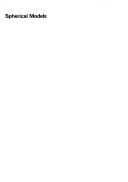
ISBN: 0521294320 Year: 1979 Publisher: Cambridge Cambridge University press
Abstract | Keywords | Export | Availability | Bookmark
 Loading...
Loading...Choose an application
- Reference Manager
- EndNote
- RefWorks (Direct export to RefWorks)
Geodesic domes --- Sphere --- Models
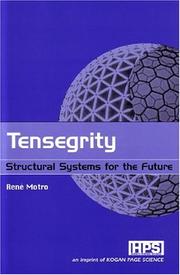
ISBN: 1281035548 9786611035549 1417526696 0080542344 1903996376 9781417526697 9781903996379 9780080542348 Year: 2003 Publisher: London Sterling, VA Kogan Page Science
Abstract | Keywords | Export | Availability | Bookmark
 Loading...
Loading...Choose an application
- Reference Manager
- EndNote
- RefWorks (Direct export to RefWorks)
The word tensegrity results from the contraction of 'tensional' and 'integrity', a word created by Richard Buckminster Fuller. He went on to describe tensegrity structures as 'islands of compression in an ocean of tension', and René Motro has developed a comprehensive definition which is 'systems in a stable self equilibriated system comprising a discontinuous set of compressed components inside a continuum of tensioned components'. This publication represents the life work of a leading exponent of a revolutionary and exciting method of structural design.* Represents the life w
Geodesic domes. --- Geodesic domes. Structural analysis (Engineering). --- Geodesic domes --- Structural analysis (Engineering) --- Tensegrity (Engineering) --- Civil Engineering --- Civil & Environmental Engineering --- Engineering & Applied Sciences --- Architectural engineering --- Engineering, Architectural --- Structural mechanics --- Structures, Theory of --- Structural engineering --- Domes
Book
ISBN: 9814452858 9789814452854 9789814452847 981445284X 9789814452861 Year: 2013 Publisher: New Jersey : World Scientific,
Abstract | Keywords | Export | Availability | Bookmark
 Loading...
Loading...Choose an application
- Reference Manager
- EndNote
- RefWorks (Direct export to RefWorks)
Based on the widely used finite element method (FEM) and the latest Meshfree methods, a next generation of numerical method called Point Interpolation Method (PIM) has been recently developed. The PIM is an innovative and effective combination of the FEM and the meshfree methods, and enables automation in computation, modeling and simulations - one of the most important features of the next generation methods. This important book describes the various PIM models in a systematic, concise and easy-to-understand manner. The underlying principles for the next generation of computational methods, G
G-spaces. --- Interpolation. --- Approximation theory --- Numerical analysis --- Geodesic spaces --- Spaces, G --- Spaces, Geodesic --- G-structures --- Metric spaces --- G-espaces. --- Interpolation (mathématiques) --- Interpolation (mathématiques)
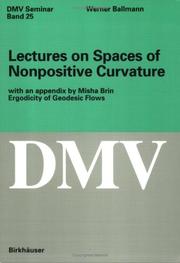
ISBN: 9783764352424 9780817652425 3764352426 0817652426 Year: 1995 Volume: 25 Publisher: Basel ; Boston : Birkhäuser Verlag,
Abstract | Keywords | Export | Availability | Bookmark
 Loading...
Loading...Choose an application
- Reference Manager
- EndNote
- RefWorks (Direct export to RefWorks)
Metric spaces --- Geodesic flows --- Espaces métriques --- Flots géodésiques
Dissertation
Year: 2024 Publisher: Liège Université de Liège (ULiège)
Abstract | Keywords | Export | Availability | Bookmark
 Loading...
Loading...Choose an application
- Reference Manager
- EndNote
- RefWorks (Direct export to RefWorks)
Facing the energy crisis and the necessity to reduce CO2 and greenhouse gas emissions, hydrogen has emerged as a key option in the decarbonization of fields such as aerospace and automotive. Indeed, hydrogen constitutes a solution in the storage and transportation of energy. Typically, hydrogen is stored in Composite Overwrapped Pressure Vessels (COPVs) which have a better strength-to-weight ratio than traditional metallic pressure vessels. However, COPVs are still subject to improvement in the filament winding process which is greatly responsible for the damage resistance and the fatigue behavior. This Master thesis addresses the implementation of a model predicting the evolution of the winding angle on the dome of cylindrical pressure vessels. The winding angle is an important parameter in the determination of the mechanical behavior of composite pressure vessels. In order to enlarge the possibility of winding trajectories, non-geodesic winding is implemented in MATLAB. The solution of the non-geodesic equation is computed using the 4th-order Runge Kutta method with a constant discretization over the dome profile. Then, the approach is extended to a multi-layer structure predicting the winding angle on an arbitrary pseudo-ply different from an ellipse. Finally, a methodology to mesh a lay-up is implemented by defining the nodes, the elements, and the winding angle associated with each element. The finite element model is then exported in SAMCEF BACON for later simulations. This results in a more realistic dome modelling by considering the different plies and the non-geodesic trajectories in the filament winding process.
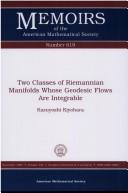
ISSN: 00659266 ISBN: 0821806408 Year: 1997 Publisher: Providence (R.I.): American Mathematical Society
Abstract | Keywords | Export | Availability | Bookmark
 Loading...
Loading...Choose an application
- Reference Manager
- EndNote
- RefWorks (Direct export to RefWorks)
Differential geometry. Global analysis --- Geodesic flows. --- Flots géodésiques. --- Riemannian manifolds. --- Riemann, Variétés de. --- Geodesic flows --- Riemannian manifolds --- Manifolds, Riemannian --- Riemannian space --- Space, Riemannian --- Geometry, Differential --- Manifolds (Mathematics) --- Flows (Differentiable dynamical systems)
Periodical
Abstract | Keywords | Export | Availability | Bookmark
 Loading...
Loading...Choose an application
- Reference Manager
- EndNote
- RefWorks (Direct export to RefWorks)
Engineering --- civil engineering --- geodesic engineering --- GIS --- remote sensing and photogrammetry --- construction fields --- Engineering. --- Construction --- Industrial arts --- Technology --- gis
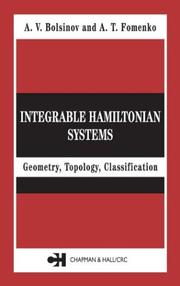
ISBN: 0415298059 Year: 2004 Publisher: Boca Raton, Fla. : Chapman & Hall/CRC,
Abstract | Keywords | Export | Availability | Bookmark
 Loading...
Loading...Choose an application
- Reference Manager
- EndNote
- RefWorks (Direct export to RefWorks)
This volume describes and fully illustrates both the theory and applications of integrable Hamiltonian systems. Exploring the basic elements of Liouville functions and their singularities, it systematically classifies such systems for the case of integrable Hamiltonian systems with two degrees of freedom. It also describes the nontrivial connections between this theory and three-dimensional topology and gives a topological description of the behavior of integral trajectories under Liouville tori bifurcation. Integrable Hamiltonian Systems: Geometry, Topology, Classification will appeal to graduate students of mathematics and mathematicians working in the theory of dynamical systems and their applications.
Hamiltonian systems. --- Geodesic flows. --- Geodesics (Mathematics) --- Systèmes hamiltoniens --- Flots géodésiques --- Geodesics (Mathematics). --- Systèmes hamiltoniens --- Flots géodésiques
| Listing 1 - 10 of 50 | << page >> |
Sort by
|

 Search
Search Feedback
Feedback About UniCat
About UniCat  Help
Help News
News